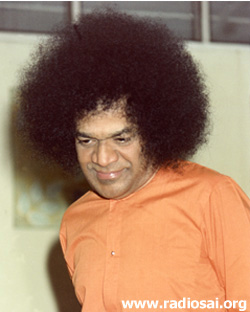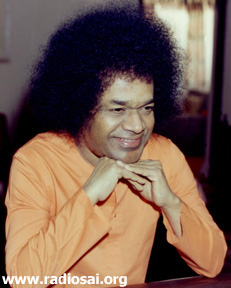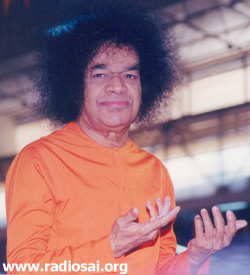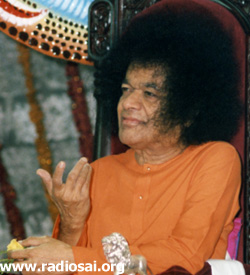 |
 |
 |
 |
| Volume
4 - Issue 03 MARCH 2006 |
|
|
"I CAME WITH YOU…" - THE UNCHANGING ‘I’
These words of Bhagavan Baba gave us a glimpse of reality, spoken to a small group of us sitting at His Lotus Feet in December 1984. They were God’s words of supreme Grace. We were a group of sixteen devotees from Australia, my family and a few members of our Sai Centre. On the very first Darshan itself, Swami glided towards me and said, “Go,” even before I could say a word! It was afternoon and some of our group weren’t ready for Darshan, as we had just arrived. During the interview I informed Bhagavan that we had come as a group from Sydney, most of us Australians of European decent and prayed to Swami to grant our group an interview and bless us with a discourse in English. We also promised Him that we would not trouble Swami with personal problems. Swami graciously replied, “Tomorrow.” There was such stillness in the air and Bhagavan broke the silence with His soft melodious voice. He spoke to us in chaste English without interruption for a very long time, starting with the words quoted above: “I came with you when you came into this world …” We were riveted to Bhagavan, as the heavenly river of Eternal Truth kept flowing from His divine lips, and the veil of ‘maya’ momentarily lifted. We were in heaven and we could have stayed there forever. He let us have a peek into our Reality, the unfailing, eternal and unsullied Love, which we truly are. It took me several years to digest what Bhagavan had revealed to us that day. I prayed and earnestly sought for the deeper meaning of what Swami had revealed. By His grace alone I stumbled upon some subtle and deeper insights into the Truth of who and what we are. Even a voluminous book cannot be comprehensive enough to answer these fundamental questions. In this article, let me confine myself to clarify my own understanding of the Divine revelations that day. “I came with you when you came into this world.” Who is this ‘I’ and who is this ‘you’ in this context? Bhagavan has always told us that there are three persons in one:
The ‘I’ is the eternal, unchanging Self, the Atma or the Divine Principle within, which we truly are. The ‘I’ is the Spirit, which gives life to the body and makes it function. It is the kernel within the body-husk. The ‘I’ is the finest and highest level of consciousness, which is the ONE all-pervading essence, the source of everything. The ‘I’ is non-matter, neither mineral nor organic, not even biological. It is the Soul alone. The soul enters the foetus and takes residence in the ever-changing physical body, from infancy to old age or any time in between, when it gets released from the ‘body-prison’ at the time of transition or death, when the body is no longer habitable, due to disease, injury or decay.
Up to 20 weeks of pregnancy the foetus is purely biological, which means it is without a soul. It is not different to any developing embryo of the lower species of life, like a developing calf in the uterus of a cow. Unlike the lower species of life, the human alone has an individual soul. The soul enters the ‘biological’ foetus around the 20th week of development in the womb. This corresponds with the onset of foetal movements, which we refer to as quickening. In the beginning the soul flits in an out of the body and finally stays put in the foetus before term. At birth the soul, which is the ‘I’, came along with the newborn. That is what Bhagavan had meant by saying: “I came with you when you came into the world.” “I am always within you, above you, below you and around you.” In this context the ‘I’ represents the all-pervading consciousness, which is Divinity Itself. Swami once gave Isaac Tigrett an example of the ‘I’ principle: Bhagavan said, “The fish that is swimming in water is surrounded by an ocean of water and is itself made mostly of water. You are like the fish, God within and ‘swimming’ in the ocean of Divinity .” The implications are that the ‘I’ in each one of us is the same ‘I’ that is in every being around us. In other words, ‘I’ that stands for Divinity or Sai, is in everyone and that is why Swami exhorts us to see Him in every person. He also cautions us: “When you hate someone you in fact hate Me!” “I have saved you from many a danger and you did not recognise Me.” This ‘I’ is in every person all the time. In bondage and ignorance we live in a limited circle of individuals and keep investing our love and resources on them, even if they are a thousand miles away. This kind of love is a bodily relationship called attachment. However, in times of desperate need those attached to us may not be near us to help us or rescue us from danger. It is then whoever happens to be in the vicinity that can come to our rescue, be them strangers or not. We may amply illustrate this by this example. A man has to make an urgent trip over mountainous roads in wintry conditions in the middle of the night. The roads are icy and the driving conditions are treacherous, with snow falling. The car skids off the road and tumbles towards a deep ravine, but for his luck the car hits a tree stump down the slope and dangles precariously, a few metres down the edge of the road. There is no one in the vicinity and the driver is dazed, unaware of the impending danger. At this odd time a truck passes by and its driver notices the blinking tail light of the car. The truck happened to be a tow-truck and had the necessary gear to winch the car up. Regardless of the weather conditions the truck driver takes the risk and fastens the cable to the car and winches it to safety. The truck driver came from nowhere and is a stranger. Who is this saviour? This saviour is not another person, a far off and unrelated individual, but the very Self, the same ‘I’ that indwells in another body whom we call a stranger. “Father, mother, son, daughter, husband, wife, brothers, sisters, nephews, nieces, cousins, uncles, aunts, grand-parents grandchildren; I have specially chosen them all for you, so that you will grow together, experience each other and evolve …” No two individuals would encounter any similarity in purpose and circumstances. Therefore it should not be far fetched for us to believe that every connection we have with another individual in this life is merely a follow on of a previous connection. Bhagavan often reminds us that everything in the vast universe is Action, Reaction, Reflection and Resound, the law of cause and effect, and deed and destiny. “… but not remain attached together for ever, for, I take them away one by one, as they fulfil their roles in your life.” Everything manifest has a beginning and an end with a period of existence in between. This existence is subject to change with time. There is nothing unchanging and everlasting in the whole of creation. This principle applies to everything created, the ever changing manifest form of the formless source of all. From birth to death a human goes through relentless changes in all facets of life on earth, which is akin to a school of experiencing, learning and realising. Each one of us is born with a syllabus, as it were, to fulfil the purpose of each sojourn on earth. All events in life and every relationship are transient. Therefore it is imperative that we learn this fact early enough and play our respective roles well in the game of life or better still, in the earth-school of learning. All attachments are enslaving and hence restrictive for soul evolution. What does Bhagavan mean by saying, “I take them away one by one, as they fulfil their roles in your life?” It is quite obvious we have to let go of our relationships one by one, one day or the other. Is God so merciless to take away our loved ones and let us drown in deep sorrow? The fact is that each one’s life on earth is road-mapped even before birth! Accordingly, when the parting time comes, it can be in one of the following ways:
Ultimately we need to realise that these relationships and friendships exist only in our mind and the trauma of separation fades away with the passage of time. They do not go beyond the mind. Let us try to understand enmities at this point. Can we ever be an enemy with a stranger or could an enemy appear from outer space? The enemy is in the mind and has come from the mind, which dwells in the past and full of desires and expectations. Someone close to us yesterday alone can become our enemy tomorrow! Our mind alone can develop enmity with another person on account of classifying his action as a gross betrayal of trust or denial of an expectation. Wars are waged in the minds of men before they actually eventuate in life. Friends! They will be with you, so long as you have wealth, position and power; but will vanish even before you loose them. Everyone who flatters thee, Who is a true friend? Is he another individual, an outer being? Can there be any permanent friendship with another? We know far too well that all external friendships are conditional and a kind of barter. Can anyone make an enemy out of a stranger? Or, is it the friend of yesterday, who has turned an enemy today? Our true friend is God and He is nearest to us as our conscience. Conscience is one and the same in all, and it is the light of consciousness within, the Chaitanya. But why does this one conscience dictate differently in each individual? It is because it is interfaced through the mind. The mind, which is tainted and restless, cannot reveal one’s conscience without distortion. Hence to develop a true and lasting friendship with God within is to develop purity and steadiness of mind. Then the true friend will always be revealed. Worldly friendships cater to the senses and the mind and have their limitations. Only by practice and experience can one nurture this eternal and pure friendship with God. I am still waiting for you totally unchanged as I was when you came into the world. Can water be anything but water, whether in the ocean, river or in the flood waters. Water remains pure in rain-cloud and is free of impurities. Once it falls as rain upon the soil it is bound to dissolve all the constituents of the soil – colour, minerals, organic matter etc. The ravaging flood is also rain-water, but has taken on the colour as well as other properties of the soil upon which it had fallen. Thus, rain water will appear differently according to the surface upon which it falls - mountain slopes, rocks, barren lands, rivers, lakes, etc. It is bound to evaporate into pure cloud once again in the intense heat of the sun. Likewise, all through our life, pure, unsullied divinity is the basis of our life, irrespective of who we appear as and what role we play. Divinity, which is our essence, has ever remained unchanged, just as the water remaining as water, however discoloured and contaminated it might be.
While addressing the doctors and staff at the Super Speciality Hospital in Prasanthi Nilayam on a visit in December 2004, Swami spoke about our possessive qualities: “You are doing good work by alleviating the suffering of patients. Swami is very happy. These are positive qualities. But you also have undesirable qualities such as ego, rivalries and dissatisfaction over trivial things. These are negative qualities. With passage of time you must give up such feelings and develop more positive qualities. In other words collect more ‘pluses’ and eliminate your ‘minuses.’ What is this ‘minus’? It is this ‘my-ness’” (Pointing His finger at His chest, Swami punned the word meaning “MY-NESS” – ‘I’ and ‘Mine’) This ‘I’ and ‘Mine” feeling is widespread, even in the animal kingdom. The following is an amazing anecdotal account about Swami’s tiny puppy: Dr. H.S. Bhat, a veteran devotee of Bhagavan, and a very senior specialist at the Hospital, was once summoned by Swami to meet Him at Trayee Brindavan, His residence in Bangalore. Swami was standing near the steps at the Trayee and His tiny puppy happened to be with Him. As Dr. Bhat approached Swami, the tiny pup barked furiously and savagely jumped at the doctor. With one word from the Lord the pup piped down. Swami remarked, “Look at the ego of this tiny creature, which can be crushed with two fingers!” Until the possessiveness goes one cannot aspire for the real proximity to Bhagavan. Come nearer and nearer to Me, Serve Me and be answerable to Me and to Me alone. When Swami uses the words, “Me” or “I”, it refers to the unchanging Reality, God. “Come nearer to Me,” means shift your focus from the worldly paradigm to the spiritual. The mind is the barrier to the Light within. All the vagaries of the mind make us succumb to the inevitable events in our life that causes grief. As we give less importance to such mental vagaries we will begin to experience the Divine strength within and the stormy mind gets subdued. That is to surrender to the Supreme Will and leave the past behind. “Answerable to Me” means that we live by our conscience, which is God. Conscience is one and the same in all. But, why do different people do conflicting things and claim to follow their conscience? Let us explore this question in a different way.
Hence, the real nearness to the divine is the attainment of purity and tranquillity of the mind, which will not discolour and distort the Light of Consciousness (Chaitanya) or Divinity within. There lies the key to liberation or freedom from bondage to the past, thus enabling us to live in the effulgent presence of the present. This alone is the true proximity to the Divine, the non-dual feeling (Advaita bhava). Whatever path we may follow and whatever means we may adopt, the sole purpose of Bhagavan Sri Sathya Sai Baba’s descent is for our ascent, to awaken our inherent divinity. Jai Sai Ram. Dr. Sara Pavan is an Anaesthesiologist from Australia, serving at the Sri Sathya Sai Institute of Higher Medical Sciences, Prashanthi Nilayam since 1993. |
| You can write to us at : h2h@radiosai.org |
Vol 4 Issue 03 - March 2006
|
Best viewed in Internet Explorer - 1024 x 768 resolution. |
DHTML Menu by Milonic. |
 The very next morning Bhagavan swiftly asked me to take the group in. In His inimitable routine of ushering in His devotees, Swami asked us to go inside and He followed us into the room. We were beginning to sit on the floor while He closed the door and switched on the fan Himself. With a circular motion of His hand thrice, Bhagavan materialised vibhuti and poured it into the hands of most of us before He sat on His throne. He looked into each one of us penetratingly, like a divine scanner switched on to probe into the past of each one of us. Then, by His tender looks, He melted away our fears and agitations to make us feel at home with Him, many of us with tears breaching its bounds. In contrast to His apparent formality and ‘distance’ at Darshan He was very informal and ‘intimate’ with us in the interview room.
The very next morning Bhagavan swiftly asked me to take the group in. In His inimitable routine of ushering in His devotees, Swami asked us to go inside and He followed us into the room. We were beginning to sit on the floor while He closed the door and switched on the fan Himself. With a circular motion of His hand thrice, Bhagavan materialised vibhuti and poured it into the hands of most of us before He sat on His throne. He looked into each one of us penetratingly, like a divine scanner switched on to probe into the past of each one of us. Then, by His tender looks, He melted away our fears and agitations to make us feel at home with Him, many of us with tears breaching its bounds. In contrast to His apparent formality and ‘distance’ at Darshan He was very informal and ‘intimate’ with us in the interview room.  From the very beginning, the developing foetus in the womb is merely made of matter, comprising of the five elements – space, air, fire, water and earth. It grows on the food consumed by the mother and that is why we refer to it as the food-sheath. The foetus starts its life from a single fertilised egg cell in the womb and it keeps multiplying into trillions of cells, which differentiate into different clusters to form different organs. There is some kind of intrinsic ‘intelligence’ that governs all this.
From the very beginning, the developing foetus in the womb is merely made of matter, comprising of the five elements – space, air, fire, water and earth. It grows on the food consumed by the mother and that is why we refer to it as the food-sheath. The foetus starts its life from a single fertilised egg cell in the womb and it keeps multiplying into trillions of cells, which differentiate into different clusters to form different organs. There is some kind of intrinsic ‘intelligence’ that governs all this. Every birth has a purpose in life. Each individual has to play his role and fulfil his assignment on earth. We take on the earthly life to fulfil the causes generated over a multitude of past lives - all the unfinished businesses, the debits and credits, the unfulfilled dreams and desires. In spiritual parlance no one whom we encounter in our life is a stranger. The cosmic intelligence is beyond the ken of human intelligence for each birth would provide us with bodily relationships in such inscrutable ways as to provide us with a perfect match in every relationship, thus giving us another opportunity to redeem ourselves.
Every birth has a purpose in life. Each individual has to play his role and fulfil his assignment on earth. We take on the earthly life to fulfil the causes generated over a multitude of past lives - all the unfinished businesses, the debits and credits, the unfulfilled dreams and desires. In spiritual parlance no one whom we encounter in our life is a stranger. The cosmic intelligence is beyond the ken of human intelligence for each birth would provide us with bodily relationships in such inscrutable ways as to provide us with a perfect match in every relationship, thus giving us another opportunity to redeem ourselves.  How true it is? Caught up in the illusions of worldly attainments, men and women run after wealthy people, who are in positions of authority, wielding power and influence. They do not realise the real seat of power, which is divinity itself, the power of love, behind and beyond all other power. I am reminded of a poem I learnt at school:
How true it is? Caught up in the illusions of worldly attainments, men and women run after wealthy people, who are in positions of authority, wielding power and influence. They do not realise the real seat of power, which is divinity itself, the power of love, behind and beyond all other power. I am reminded of a poem I learnt at school: 
 If conscience is God and there is only one God and only one conscience, then why do people have divergent views and opinions? They claim that they are following their conscience. Is there a ‘filter’ or an interface one’s conscience as God deep within has to negotiate to be revealed? Yes, the mind is the sole interface between God and man. As is the perversion of the mind so is the degree of distortion of conscience, which emanates from the one Atma within. Hence the conflict rests within the mind. Every personality operates at the level of the mind, while every person is truly divine. All action is God’s will and all reactions to preordained events are attributable to the mind. Spiritual training of the mind alone can help us overcome its negative impact. Therefore, Bhagavan lays great emphasis on the purity of mind, to free us from the ‘discolouration’ and ‘turbulence’ or restlessness of the mind; in other words, develop Constant Integrated Awareness.
If conscience is God and there is only one God and only one conscience, then why do people have divergent views and opinions? They claim that they are following their conscience. Is there a ‘filter’ or an interface one’s conscience as God deep within has to negotiate to be revealed? Yes, the mind is the sole interface between God and man. As is the perversion of the mind so is the degree of distortion of conscience, which emanates from the one Atma within. Hence the conflict rests within the mind. Every personality operates at the level of the mind, while every person is truly divine. All action is God’s will and all reactions to preordained events are attributable to the mind. Spiritual training of the mind alone can help us overcome its negative impact. Therefore, Bhagavan lays great emphasis on the purity of mind, to free us from the ‘discolouration’ and ‘turbulence’ or restlessness of the mind; in other words, develop Constant Integrated Awareness.